Macon, Georgia
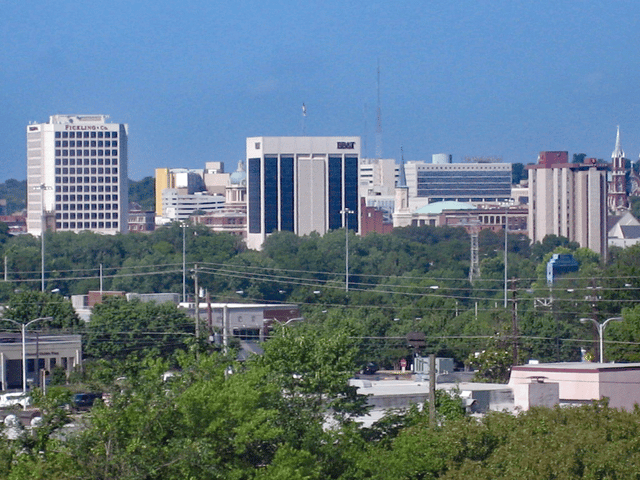
Macon, Georgia

Macon, Georgia | |
|---|---|
Consolidated city-county | |
| Macon–Bibb County | |
 Location within Bibb County | |
| Coordinates:32°50′5″N 83°39′6″W [120] | |
| Country | United States |
| State | Georgia |
| County | Bibb |
| Government | |
| • Mayor | Robert Reichert (D) |
| Area | |
| • Consolidated city-county | 661 km2 (255.13 sq mi) |
| • Land | 647 km2(249.96 sq mi) |
| • Water | 3.2 km2(0.5 sq mi) |
| Elevation | 116 m (381 ft) |
| Population (2018) | |
| • Consolidated city-county | 153,095[5] |
| • Metro | 228,914 (197th) |
| • CSA | 420,693 (97th) |
| • Demonym | Maconites |
| Time zone | UTC−5 (EST) |
| • Summer (DST) | UTC−4 (EDT) |
| ZIP Codes | 31200–31299 |
| Area code(s) | 478 |
| FIPS code | 13-49000[6] |
| GNIS feature ID | 0332301[7] |
| Website | maconbibb.us [121] |
Macon (/ˈmeɪkən/), officially Macon–Bibb County, is a consolidated city-county located in the U.S. state of Georgia. Macon lies near the geographic center of the state, approximately 85 miles (137 km) south of Atlanta, hence the city's nickname "The Heart of Georgia".
Located near the fall line of the Ocmulgee River, Macon had a 2017 estimated population of 152,663.[8] Macon is the principal city of the Macon metropolitan area, which had an estimated population of 228,914 in 2017. Macon is also the largest city in the Macon–Warner Robins Combined Statistical Area (CSA), a larger trading area with an estimated 420,693 residents in 2017; the CSA abuts the Atlanta metropolitan area just to the north.
In a 2012 referendum, voters approved the consolidation of the governments of the City of Macon and Bibb County, and Macon became Georgia's fourth-largest city (just after Columbus). The two governments officially merged on January 1, 2014.[9]
Macon is served by three interstate highways: I-16 (connecting the city to Savannah and coastal Georgia), I-75 (connecting the city with Atlanta to the north and Valdosta to the south), and I-475 (a city bypass highway).
The city has several institutions of higher education, as well as numerous museums and tourism sites. The area is served by the Middle Georgia Regional Airport and the Herbert Smart Downtown Airport. The mayor of Macon is Robert Reichert, a former Democratic member of the Georgia House of Representatives. Reichert was elected mayor of the newly consolidated city of Macon–Bibb, and he took office on January 1, 2014.[10]
Macon, Georgia | |
|---|---|
Consolidated city-county | |
| Macon–Bibb County | |
 Location within Bibb County | |
| Coordinates:32°50′5″N 83°39′6″W [120] | |
| Country | United States |
| State | Georgia |
| County | Bibb |
| Government | |
| • Mayor | Robert Reichert (D) |
| Area | |
| • Consolidated city-county | 661 km2 (255.13 sq mi) |
| • Land | 647 km2(249.96 sq mi) |
| • Water | 3.2 km2(0.5 sq mi) |
| Elevation | 116 m (381 ft) |
| Population (2018) | |
| • Consolidated city-county | 153,095[5] |
| • Metro | 228,914 (197th) |
| • CSA | 420,693 (97th) |
| • Demonym | Maconites |
| Time zone | UTC−5 (EST) |
| • Summer (DST) | UTC−4 (EDT) |
| ZIP Codes | 31200–31299 |
| Area code(s) | 478 |
| FIPS code | 13-49000[6] |
| GNIS feature ID | 0332301[7] |
| Website | maconbibb.us [121] |
History
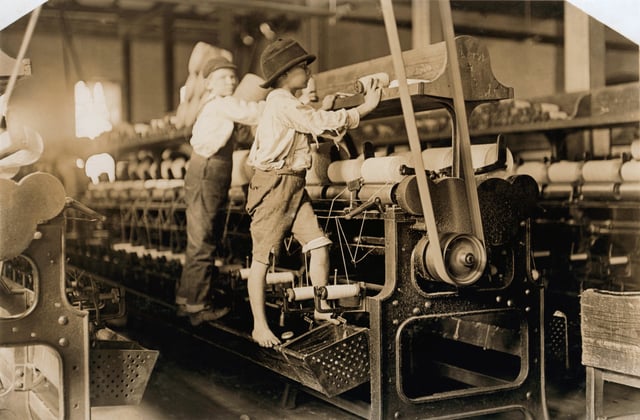
Child labor in Macon, 1909. Photo by Lewis Hine.
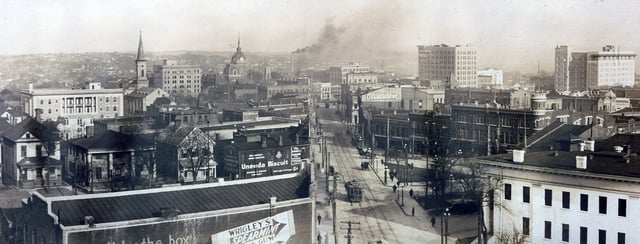
Downtown Macon in the early 1900s, looking northeast near the intersections of Cotton Avenue, First Street and Poplar Street.
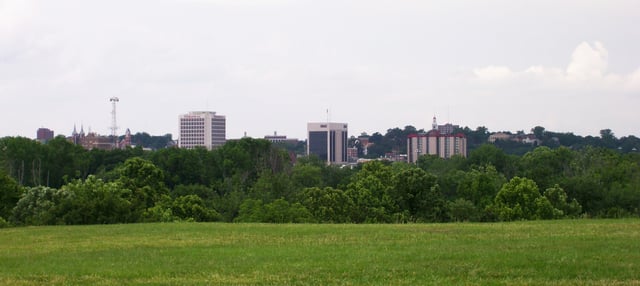
Downtown Macon seen from the Ocmulgee National Monument
Macon was founded on the site of the Ocmulgee Old Fields, where the Creek Indians lived in the 18th century. Their predecessors, the Mississippian culture, built a powerful chiefdom (950–1100 AD) based on the practice of agriculture. The Mississippian culture constructed earthwork mounds for ceremonial, burial, and religious purposes. The areas along the rivers in the Southeast had been inhabited by indigenous peoples for 13,000 years before Europeans arrived.[11]
Macon developed at the site of Fort Benjamin Hawkins, built in 1809 at the fall line of the Ocmulgee River to protect the community and to establish a trading post with Native Americans. The fort was named in honor of Benjamin Hawkins, Superintendent of Indian Affairs for the Southeast territory south of the Ohio River for over 20 years. He lived among the Creek and was married to a Creek woman. This was the most inland point of navigation on the river from the Low Country. President Thomas Jefferson forced the Creek to cede their lands east of the Ocmulgee River and ordered the fort built. (Archeological excavations in the 21st century found evidence of two separate fortifications.)[12]
Fort Hawkins guarded the Lower Creek Pathway, an extensive and well-traveled American Indian network later improved by the United States as the Federal Road from Washington, D.C., to the ports of Mobile, Alabama and New Orleans, Louisiana.[12] A gathering point of the Creek and U.S. cultures for trading, it was also a center of state militia and federal troops. The fort served as a major military distribution point during the War of 1812 against Great Britain and also during the Creek War of 1813. Afterward, the fort was used as a trading post for several years and was garrisoned until 1821. It was decommissioned about 1828 and later burned to the ground. A replica of the southeast blockhouse was built in 1938 and still stands today on a hill in east Macon. Part of the fort site is occupied by the Fort Hawkins Grammar School.[12] In the 21st century, archeological excavations have revealed more of the fort's importance, and stimulated planning for additional reconstruction of this major historical site.
As many Europeans had already begun to move into the area, Fort Hawkins was renamed "Newtown." After the organization of Bibb County in 1822, the city was chartered as the county seat in 1823 and officially named Macon. This was in honor of the North Carolina statesman Nathaniel Macon,[13] because many of the early residents of Georgia hailed from North Carolina. The city planners envisioned "a city within a park" and created a city of spacious streets and parks. They designated 250 acres (1.0 km2) for Central City Park, and passed ordinances requiring residents to plant shade trees in their front yards.
The city thrived due to its location on the Ocmulgee River, which enabled shipping to markets. Cotton became the mainstay of Macon's early economy,[14] based on the enslaved labor of African Americans. Macon was in the Black Belt of Georgia, where cotton was the commodity crop. Cotton steamboats, stage coaches, and later, in 1843, a railroad increased marketing opportunities and contributed to the economic prosperity to Macon. In 1836, the Georgia Conference of the Methodist Episcopal Church founded Wesleyan College in Macon. Wesleyan was the first college in the United States chartered to grant degrees to women.[15] In 1855, a referendum was held to determine a capital city for Georgia. Macon came in last with 3,802 votes.[16]
During the American Civil War, Macon served as the official arsenal of the Confederacy[14] manufacturing percussion caps, friction primers, and pressed bullets.[17] Camp Oglethorpe, in Macon, was used first as a prison for captured Union officers and enlisted men. Later it held officers only, up to 2,300 at one time. The camp was evacuated in 1864.[18]
Macon City Hall, which served as the temporary state capitol in 1864, was converted to a hospital for wounded Confederate soldiers. The Union General William Tecumseh Sherman spared Macon on his march to the sea. His troops had sacked the nearby state capital of Milledgeville, and Maconites prepared for an attack. Sherman, however, passed by without entering Macon.
The Macon Telegraph wrote that, of the 23 companies which the city had furnished the Confederacy, only enough men survived and were fit for duty to fill five companies by the end of the war. The human toll was very high.[19]
The city was taken by Union forces during Wilson's Raid on April 20, 1865.[20]
In the twentieth century, Macon grew into a prospering town in Middle Georgia. It began to serve as a transportation hub for the entire state. In 1895, the New York Times dubbed Macon "The Central City," in reference to the city's emergence as a hub for railroad transportation and textile factories.[21] Terminal Station was built in 1916.[22]
In 1994 Tropical Storm Alberto made landfall in Florida bringing 24 inches (61 cm) of rain, which resulted in major flooding in Georgia. Macon was one of the cities to suffer the worst flooding.[23]
On May 11, 2008, an EF2 tornado touched down in nearby Lizella. The tornado then moved northeast to the southern shore of Lake Tobesofkee then continued into Macon and lifted near Dry Branch in Twiggs County. The tornado produced sporadic areas of major damage. Widespread straight-line wind damage was also produced along and south of the track of the tornado. The most significant damage was in Macon along Eisenhower Parkway and Pio Nono Avenue where two businesses were destroyed and several others were heavily damaged. Middle Georgia State College was also damaged by the tornado, snapping or uprooting around 50% of the campus trees and doing significant damage to several buildings on campus, with the gymnasium sustaining the worst damage. This tornado varied in intensity from EF0 to EF2 with the EF2 damage and winds up to 130 miles per hour (210 km/h) occurring near the intersection of Eisenhower Parkway and Pio Nono Avenue. Total path length was 18 miles (29 km) with a path width of 100 yards (91 m).
In 2012, voters in Macon and Bibb County approved a new consolidated government between the city and county, making the city's new boundary lines the same as the county's and reversing the annexation of a small portion of the city that once lay in Jones County.[9]
Consolidation
On July 31, 2012, voters in Macon (57.8 percent approval) and Bibb County (56.7 percent approval) passed a referendum to merge the governments of the city of Macon and most of unincorporated Bibb County, based on the authorization of House Bill 1171, passed by the Georgia General Assembly earlier in the year;[24] four previous consolidation attempts (in 1933, 1960, 1972, and 1976) had failed.[25][26][27]
Under the consolidation, the governments of Macon and Bibb County were replaced with a single mayor and a nine-member countywide commission elected to office by county districts. A portion of Macon that extends into nearby Jones County was disincorporated from Macon. Robert Reichert is the first mayor of Macon-Bibb after the election in September 2013 and a runoff with C. Jack Ellis in October.[10][28][29][30]
Timeline
1806 - U.S. Fort Hawkins built at present-day site of Creek Indian Ocmulgee Old Fields (future site of Macon).[31]
1821 - Fort Hawkins settlement renamed "Newtown."[31]
1822 - Bibb County created.[32]
1823 - Town of Macon incorporated; named after North Carolina statesman Nathaniel Macon.[31]
1826 Macon Telegraph newspaper begins publication.[33] First Presbyterian Church founded.[34]
1829 - Newtown becomes part of Macon.[31]
1833 - Steamboat in operation.[31]
1834 - City of Macon incorporated.[35]
1835 - Robert Augustus Beall elected mayor.
1836 - Monroe Railroad Bank built.[36]
1838 - Monroe Railroad (Forsyth-Macon) begins operating.[35]
1839 - Georgia Female College opens.[37]
1840 Rose Hill Cemetery established. Population: 3,927.[38]
1843 - Savannah-Macon railway begins operating.[36]
1846 - Small House (residence) built (approximate date).[36]
1848 - Telegraph begins operating.[39]
1860 Belgian Fair and Cotton Planters' Exposition held.[36] Population: 8,247.[38]
1862 - "Arsenal of the Confederate Government moved to Macon" during the American Civil War.[39]
1864 July 30: Macon besieged by Union forces.[35] "City Hall made temporary State Capitol of Georgia."[39]
1865 - April 20: Macon occupied by Union forces.[31]
1866 - October 29: Equal Rights and Educational Association of Georgia meeting held in Macon.[41]
1871 Mercer University relocates to Macon from Penfield.[35] Bibb Manufacturing Company in business.[36]
1874 - Public Library (social library) established.[42]
1876 - Mount de Sales Academy active.
1880 Telephone begins operating.[39] Population: 12,749.[38]
1884 Macon Daily News begins publication.[33] Academy of Music built.
1887 April 6: Riverside Cemetery chartered[43] August 6: Woolfolk family murdered near Macon.[44]
1900 - Price Library (public library) opens.[45]
1906 - Ocmulgee River levee construction begins.[36]
1910 - Population: 40,665.
1917 - Cox Capitol Theatre in business.
1918 National Association for the Advancement of Colored People Columbus branch organized (approximate date).[46] Macon Art Association formed.[47] Outbreak of Spanish flu.[44]
1919 - Washington Memorial Library (public library) established.[36]
1921 - Douglass Theatre and Rialto Theatre in business.[48]
1922 WMAZ radio begins broadcasting.[49] Sherah Israel Synagogue built.[50]
1925 - Macon City Auditorium built.[36]
1929 - Luther Williams Field (stadium) opens.
1933 - Citizens & Southern National Bank building constructed.[36]
1936 Ocmulgee National Monument established. Farmer's Market built.[36]
1938 - Bibb Theatre in business.[48]
1948 - WIBB radio begins broadcasting.
1949 - Middle Georgia Regional Library headquartered in Macon.
1950 - Population: 70,252.
1952 - Georgia Journal newspaper begins publication.[33]
1953 - WMAZ-TV begins broadcasting.[51]
1955 - "Singer James Brown records his first single 'Please Please Please' at the studio of WIBB" radio in Macon.[39]
1960 - "Stratford Academy founded"
1964 - Middle Georgia Historical Society formed.[52]
1965 - Macon Junior College established.[35]
1966 - U.S. Supreme Court decides Evans v. Newton desegregation-related lawsuit.[53]
1967 December 18: Funeral of musician Otis Redding.[44] Ronnie Thompson becomes mayor.
1970 - Population: 122,423.
1978 - Middle Georgia Archives organized.[54]
1983 Cherry Blossom Festival begins.[39] Richard Ray becomes U.S. representative for Georgia's 3rd congressional district.[55]
1993 - Sanford Bishop becomes U.S. representative for Georgia's 2nd congressional district.[56]
1994 July: Flood.[39] Georgia Sports Hall of Fame relocates to Macon.[44]
1999 - C. Jack Ellis becomes mayor.[39]
2000 - Population: 97,255.
2001 - City website online (approximate date).[57]
2003 - Historic Macon Foundation formed.[58]
2007 - Robert Reichert becomes mayor.
2010 - Population: 91,351.[59]
2012 - Governments of Macon city and Bibb County consolidated.
2015 - Middle Georgia State University active.
Geography
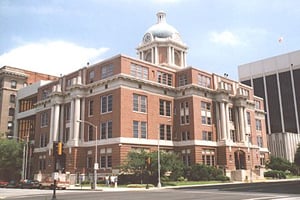
The Macon-Bibb County Courthouse
The Ocmulgee River is a major river that runs through the city. Macon is one of Georgia's three major Fall Line Cities, along with Augusta and Columbus. The Fall Line is where the hilly lands of the Piedmont plateau meet the flat terrain of the coastal plain. As such, Macon has a varied landscape of rolling hills on the north side and flat plains on the south. The fall line, where the altitude drops noticeably, causes rivers and creeks in the area to flow rapidly toward the ocean. In the past, Macon and other Fall Line cities had many textile mills powered by the rivers.
According to the United States Census Bureau, the city has a total area of 56.3 square miles (146 km2), of which 55.8 square miles (145 km2) is land and 0.5 square miles (1.3 km2) (0.82%) is water.
Macon is approximately 330 feet (100 m) above sea level.[7]
Climate
Macon has a humid subtropical climate (Köppen climate classification Cfa). The normal monthly mean temperature ranges from 46.3 °F (7.9 °C) in January to 81.8 °F (27.7 °C) in July. On average, there are 4.8 days with 100 °F (38 °C)+ highs,[1] 83 days with 90 °F (32 °C)+ highs,[2] and 43 days with a low at or below freezing; the average window for freezing temperatures is November 7 thru March 22, allowing a growing season of 228 days. The city has an average annual precipitation of 45.7 inches (1,160 mm). Snow is occasional, with about half of the winters receiving trace amounts or no snowfall, averaging 0.7 inches (1.8 cm); the snowiest winter was 1972−73 with 16.5 in (42 cm).[61][62][63]
| Climate data for Macon, Georgia (Middle Georgia Regional Airport), 1981−2010 normals,[3] extremes 1892−present[4] | |||||||||||||
|---|---|---|---|---|---|---|---|---|---|---|---|---|---|
| Month | Jan | Feb | Mar | Apr | May | Jun | Jul | Aug | Sep | Oct | Nov | Dec | Year |
| Record high °F (°C) | 84 (29) | 85 (29) | 92 (33) | 96 (36) | 100 (38) | 108 (42) | 108 (42) | 105 (41) | 105 (41) | 100 (38) | 88 (31) | 82 (28) | 108 (42) |
| Mean maximum °F (°C) | 73.9 (23.3) | 76.7 (24.8) | 83.7 (28.7) | 88.6 (31.4) | 93.3 (34.1) | 97.8 (36.6) | 99.4 (37.4) | 98.8 (37.1) | 94.7 (34.8) | 88.4 (31.3) | 81.6 (27.6) | 75.9 (24.4) | 100.6 (38.1) |
| Average high °F (°C) | 57.8 (14.3) | 62.1 (16.7) | 69.5 (20.8) | 76.8 (24.9) | 84.6 (29.2) | 90.3 (32.4) | 92.6 (33.7) | 91.4 (33.0) | 86.1 (30.1) | 77.4 (25.2) | 68.8 (20.4) | 59.6 (15.3) | 76.4 (24.7) |
| Average low °F (°C) | 34.8 (1.6) | 38.0 (3.3) | 44.1 (6.7) | 50.1 (10.1) | 59.2 (15.1) | 67.6 (19.8) | 71.0 (21.7) | 70.3 (21.3) | 63.9 (17.7) | 52.4 (11.3) | 43.0 (6.1) | 36.4 (2.4) | 52.6 (11.4) |
| Mean minimum °F (°C) | 17.8 (−7.9) | 22.0 (−5.6) | 27.5 (−2.5) | 34.3 (1.3) | 45.6 (7.6) | 57.6 (14.2) | 64.8 (18.2) | 62.7 (17.1) | 50.5 (10.3) | 35.2 (1.8) | 27.7 (−2.4) | 20.5 (−6.4) | 14.8 (−9.6) |
| Record low °F (°C) | −6 (−21) | 8 (−13) | 14 (−10) | 28 (−2) | 40 (4) | 46 (8) | 56 (13) | 55 (13) | 35 (2) | 26 (−3) | 10 (−12) | 5 (−15) | −6 (−21) |
| Average precipitation inches (mm) | 4.24 (108) | 4.36 (111) | 4.55 (116) | 2.96 (75) | 2.72 (69) | 4.06 (103) | 4.95 (126) | 4.10 (104) | 3.59 (91) | 2.79 (71) | 3.32 (84) | 4.04 (103) | 45.68 (1,161) |
| Average snowfall inches (cm) | 0.4 (1.0) | trace | 0.2 (0.51) | 0 (0) | 0 (0) | 0 (0) | 0 (0) | 0 (0) | 0 (0) | 0 (0) | 0 (0) | 0.1 (0.25) | 0.7 (1.8) |
| Average precipitation days(≥ 0.01 in) | 10.1 | 9.0 | 8.9 | 7.7 | 7.8 | 10.3 | 11.4 | 10.4 | 7.3 | 6.2 | 7.9 | 8.8 | 105.8 |
| Average snowy days(≥ 0.1 in) | 0.3 | 0.2 | 0.1 | 0 | 0 | 0 | 0 | 0 | 0 | 0 | 0 | 0.1 | 0.7 |
| Average relative humidity (%) | 70.2 | 67.2 | 66.6 | 64.8 | 68.5 | 70.7 | 74.2 | 76.1 | 76.4 | 71.2 | 71.1 | 70.9 | 70.7 |
| Mean monthly sunshine hours | 179.5 | 192.2 | 250.8 | 283.2 | 315.3 | 300.0 | 293.9 | 288.0 | 247.4 | 253.7 | 200.2 | 182.2 | 2,986.4 |
| Percent possible sunshine | 56 | 62 | 67 | 73 | 73 | 70 | 67 | 70 | 67 | 72 | 64 | 59 | 67 |
| Source: NOAA (relative humidity and sun 1961−1990)[61][64][65] | |||||||||||||
Surrounding cities and towns
Demographics

Location of the Macon-Warner Robins-Fort Valley CSA and its components: Macon Metropolitan Statistical Area Warner Robins Metropolitan Statistical Area
| Historical population | |||
|---|---|---|---|
| Census | Pop. | %± | |
| 1840 | 3,297 | — | |
| 1850 | 5,720 | 73.5% | |
| 1860 | 8,247 | 44.2% | |
| 1870 | 10,810 | 31.1% | |
| 1880 | 12,749 | 17.9% | |
| 1890 | 22,746 | 78.4% | |
| 1900 | 23,272 | 2.3% | |
| 1910 | 40,665 | 74.7% | |
| 1920 | 52,995 | 30.3% | |
| 1930 | 53,829 | 1.6% | |
| 1940 | 57,865 | 7.5% | |
| 1950 | 70,252 | 21.4% | |
| 1960 | 69,764 | −0.7% | |
| 1970 | 122,423 | 75.5% | |
| 1980 | 116,896 | −4.5% | |
| 1990 | 106,612 | −8.8% | |
| 2000 | 97,255 | −8.8% | |
| 2010 | 91,351 | −6.1% | |
| Est. 2018 | 153,095 | [66] | 67.6% |
Macon is the largest principal city of the Macon-Warner Robins-Fort Valley CSA, a Combined Statistical Area that includes the Macon metropolitan area (Bibb, Crawford, Jones, Monroe, and Twiggs counties) and the Warner Robins metropolitan area (Houston, Peach, and Pulaski counties), which had a combined population of 411,898 at the 2010 census.[6]
As of the official 2010 U.S. Census,[6] the population of Macon was 91,351. In the last official census, in 2000, there were 97,255 people, 38,444 households, and 24,219 families residing in the city. The population density was 1,742.8 people per square mile (672.9/km2). There were 44,341 housing units at an average density of 794.6 per square mile (306.8/km2). The racial makeup of the city was 67.94% African American, 28.56% White, 0.02% Native American, 0.65% Asian, 0.03% Pacific Islander, 0.46% from other races, and 0.77% from two or more races. Hispanic or Latino of any race were 2.48% of the population.
There were 38,444 households out of which 30.1% had children under the age of 18 living with them, 33.0% were married couples living together, 25.7% had a female householder with no husband present, and 37.0% were non-families. 31.7% of all households were made up of individuals and 12.1% had someone living alone who was 65 years of age or older. The average household size was 2.44 and the average family size was 3.08.
In the city, the population was spread out with 26.9% under the age of 18, 11.3% from 18 to 24, 27.5% from 25 to 44, 20.0% from 45 to 64, and 14.3% who were 65 years of age or older. The median age was 34 years. For every 100 females, there were 79.7 males. For every 100 females age 18 and over, there were 72.8 males.
Economy
Personal income
According to the 2010 Census, the median household income in the city was $28,366, as compared with the state average of $49,347. The median family income was $37,268. Full-time working males had a median income of $34,163 versus $28,082 for females. The per capita income for the city was $17,010. About 24.1% of families and 30.6% of the population were below the poverty line, including 43.6% of those under age 18 and 18.4% of those over 65.[67]
Retail
Malls include: The Shoppes at River Crossing, Macon Mall, and Eisenhower Crossing. Traditional shopping centers are in the downtown area, and Ingleside Village.[68]
Military
Robins Air Force Base, the largest single-site industrial complex in the state of Georgia,[69] is just 10 miles south of Macon on Highway 247 next to the city of Warner Robins.
The headquarters of the 48th Infantry Brigade Combat Team, Georgia Army National Guard is located in Macon.
Arts and culture
Musical heritage
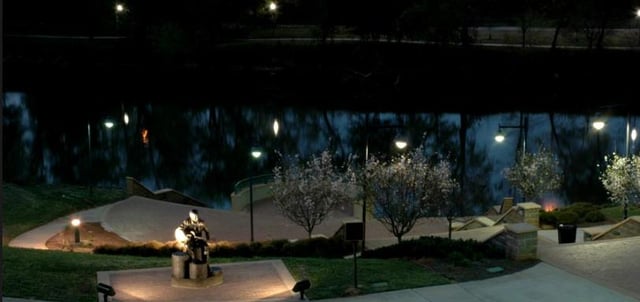
A statue of Otis Redding
Macon is the birthplace or hometown of musicians Emmett Miller, The Allman Brothers Band, Randy Crawford, Mark Heard, Lucille Hegamin, Otis Redding, Little Richard, Mike Mills,[70] and Bill Berry of R.E.M., as well as more recent artists like violinist Robert McDuffie and country artist Jason Aldean. September Hase, an alternative rock band, was discovered in Macon. Capricorn Records, run by Macon natives Phil Walden and briefly Alan Walden, made the city a hub for Southern rock music in the late 1960s and 1970s.[71] Composer Ben Johnston was also born in Macon.
Festivals
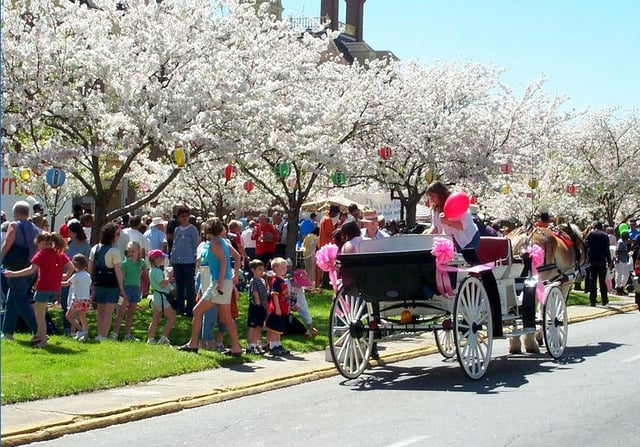
Cherry Blossom Festival
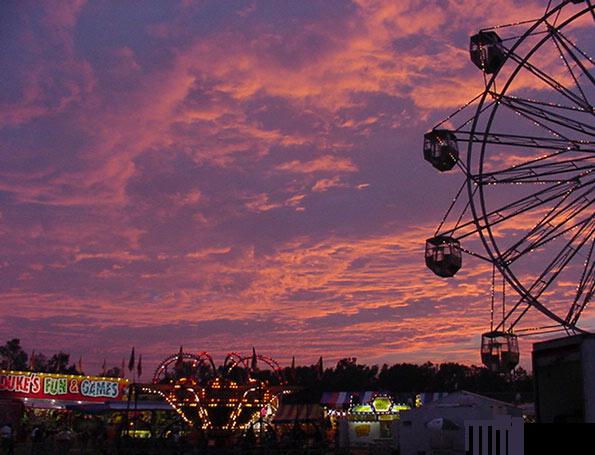
Georgia State Fair
International Cherry Blossom Festival - a 10-day celebration held every mid-March in Macon
The Mulberry Street Festival[74] - an arts and crafts festival held downtown the last weekend of March
The Juneteenth Freedom Festival - An annual June performing arts and educational celebration of the end of American slavery in 1865, celebrating black freedom and heritage both ancient and contemporary
Pan African Festival - An annual celebration of the African diaspora and culture, held in April
Ocmulgee Indian Celebration - A celebration of the original residents of the land where Macon now sits, this festival is held in September at Ocmulgee National Monument. Representatives from the Cherokee, Chickasaw, Choctaw, Creek, Seminole, and other nations come to share stories, exhibit Native art, and perform traditional songs and dance.
The Georgia Music Hall of Fame hosts Georgia Music Week in September.
Macon's annual Bragg Jam festival features an Art and Kids' Festival along the Ocmulgee Heritage Trail and a nighttime Pub Crawl.
Macon Film Festival[75] - An annual celebration of independent films, held the third weekend in July
Points of interest
Historical sites
Terminal Station is a railroad station that was built in 1916,[22] and is located on 5th St. at the end of Cherry St. It was designed by architect Alfred Fellheimer, prominent for his design of Grand Central Terminal in New York City in 1903.
Ocmulgee National Monument is located near downtown Macon. It preserves some of the largest ancient earthwork mounds in Georgia built by the Mississippian culture a millennium ago, c. 950-1150. It was sacred to the historic Muscogee (Creek Nation) as well. Archeological artifacts reveal 13,000 years of human habitation at the site.[11] The park features a spiral mound, funeral mound, temple mounds, burial mounds, and a reconstructed earth lodge. It is the first Traditional Cultural Property designated by the National Park Service east of the Mississippi River.
Fort Benjamin Hawkins, a major military outpost (1806-1821), was a command headquarters for the U.S. Army and Georgia militia on the boundary between U.S.-held and Native land, as well as a trading post or factory for the Creek Nation. It was a supply depot during U.S. campaigns of the War of 1812 and the Creek and Seminole Wars.
Cannonball House - historic site[76]
Luther Williams Field
Rose Hill Cemetery - one of Macon's oldest cemeteries
Sidney Lanier Cottage - historical home of the poet Sidney Lanier[77]
Temple Beth Israel - The Jewish congregation was founded in 1859, and now occupies a domed Neoclassical facility built in 1902.[78]
Wesleyan College - first chartered women's college in the world
Museums
The Allman Brothers Band Museum - the "Big House" used by the Allman Brothers Band in the early 1970s, now a museum of Allman Brothers history and artifacts
The Georgia Children's Museum[79] - interactive education, located in the downtown Museum District
Georgia Sports Hall of Fame
Museum of Arts and Sciences (Macon) and Planetarium
Tubman Museum of African American Art, History, and Culture - the largest African American museum in the Southeast
Community
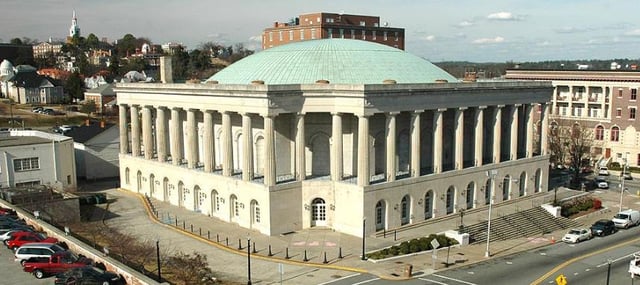
Macon City Auditorium -- World's Largest True Copper Dome
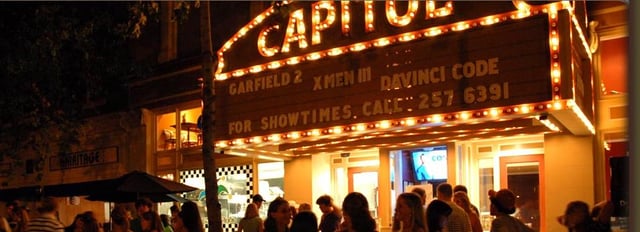
Cox Capitol Theater
City Hall, Georgia's capitol for part of the Civil War
Douglass Theatre, named for its founder Charles Henry Douglas. An entrepreneur from a prominent black family, he was an established theatre developer well versed in the vaudeville and entertainment business. The theatre has undergone modern renovations and hosts numerous theatrical events.
The Grand Opera House, where the Macon Symphony Orchestra performs
Hay House - also known as the "Johnston-Felton-Hay House," it has been referred to as the "Palace of the South"[80]
City Auditorium, the world's largest true copper dome [81]
Macon Coliseum
Macon Little Theatre, established in 1934, the area's oldest community theatre, producing seven plays/musicals per season
Waddell Barnes Botanical Gardens
Theatre Macon, which is in the old Ritz theatre where they perform around nine shows a year
Sports
Macon is home to the Mercer Bears, who compete at the NCAA Division I level in sports that include soccer (men's and women's), football, baseball, basketball (men's and women's), tennis, and lacrosse. Central Georgia Technical College also competes in men's and women's basketball. Wesleyan College, an all-female school, has teams in basketball, soccer, cross country, tennis, softball, and volleyball.
| Club | Sport | League | Venue |
|---|---|---|---|
| Macon Bacon[82] | Baseball | Coastal Plain League | Luther Williams Field |
| Macon Mayhem | Ice hockey | Southern Professional Hockey League | Macon Coliseum |
Former teams
| Club | Sport | League | Venue | Active |
|---|---|---|---|---|
| Macon State College Blue Storm | Various | NCCAA | Various | 2009–2013 |
| Macon Central City/Hornets | Baseball | Southern League | Central City Park | 1892–1894 |
| Macon Highlanders/Brigands/Peaches/Tigers | Baseball | South Atlantic League | Central City Park and Luther Williams Field | 1904–1917, 1923–1930 |
| Macon Peaches/Dodgers/Redbirds/Pirates | Baseball | Southeastern League (1932), South Atlantic League (1936–42, 1946–60, 1962–63, 1980-87), Southern Association (1961), Southern League (1964, 1966–67) | Luther Williams Field | 1932, 1936–1942, 1946–1960, 1961–1964, 1966–1967, 1980–1982 |
| Macon Braves | Baseball | South Atlantic League | Luther Williams Field | 1991–2002 |
| Macon Peaches | Baseball | Southeastern League | Luther Williams Field | 2003 |
| Macon Music | Baseball | South Coast League | Luther Williams Field | 2007 |
| Macon Pinetoppers | Baseball | Peach State League | Luther Williams Field | 2010 |
| Macon Blaze | Basketball | World Basketball Association | Macon Coliseum | 2005 |
| Macon Whoopees | Ice hockey | Southern Hockey League | Macon Coliseum | 1974 |
| Macon Whoopee | Ice hockey | Central Hockey League (1996-2001), ECHL (2001-02) | Macon Coliseum | 1996–2002 |
| Macon Trax | Ice hockey | Atlantic Coast Hockey League (2002–03), World Hockey Association 2 (2003-04), Southern Professional Hockey League (2004–05) | Macon Coliseum | 2002–2005 |
| Macon Knights | Arena football | af2 | Macon Coliseum | 2001–2006 |
| Macon Steel | Indoor football | American Indoor Football | Macon Coliseum | 2012 |
| Georgia Doom | Indoor football | American Arena League | Macon Coliseum | 2018–2019 |
Parks and recreation
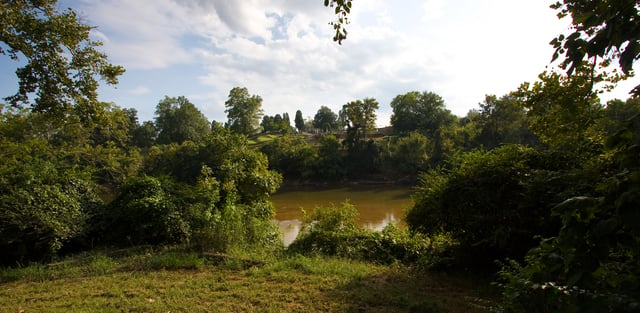
Ocmulgee Riverwalk
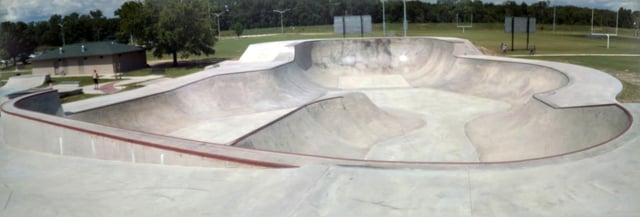
Central City Skatepark
The city maintains several parks and community centers.[83]
Ocmulgee Heritage Trail - a green way of parks, plazas, and landmarks along the Ocmulgee River in downtown Macon
Bloomfield Park
East Macon Park
Frank Johnson Recreation Center
Freedom Park
L.H. Williams Community School Center
Memorial Park
North Macon Park
Rosa Jackson
Senior Center
John Drew Smith Tennis Center
Tattnall Square Tennis Center
Gateway Park Otis Redding[84]
Central City Park
Central City Skatepark
Government
The first Mayor, Robert Reichert is the present mayor after being re~elected in 2016. Mayor Reichert is a former member of the Georgia House of Representatives District 126.[85]
Dale M. Walker ~ Macon~Bibb, County Manager 2014 to 2017[86]
The city council is, to date, the only city council in Georgia to conduct partisan elections, with the city council leaning mostly to the Democratic Party.
On March 15, 2019, the U.S. Securities and Exchange Commission charged "the former County Manager" Dale M. Walker with fraud.[87]
Education
Public high schools
Private high schools
Central Fellowship Christian Academy
First Presbyterian Day School
Mount de Sales Academy
Stratford Academy
Tattnall Square Academy
Windsor Academy
Covenant Academy[93]
Bethany Christian Academy
Private and specialized schools
Colleges and universities
Approximately 30,000 college students live in the greater Macon area.[99] Mercer, Middle Georgia State University, and Wesleyan College have the largest populations of "traditional" college students.
Mercer University
Middle Georgia State University
Wesleyan College
Central Georgia Technical College
Miller-Motte Technical College - satellite campus
Media
Macon has a substantial number of local television and radio stations. It is also served by two local papers.
Newspapers and magazines
The Telegraph, a daily newspaper, is published in Macon.
The 11th Hour
Gateway Macon (web portal), The Local's Guide for Things To Do in Macon.
Macon Business Journal, a journal chronicling the business community in the Middle Georgia region.
The Mercer Cluster
Macon Community News, a monthly positive news print newspaper.
Infrastructure
Hospitals
Central Georgia Rehabilitation Hospital
Coliseum Medical Centers
Coliseum Northside Hospital
The American Red Cross Of Central Georgia
The Medical Center of Central Georgia
The Children Hospital Of Central Georgia
Transportation
Airports
Macon Downtown Airport is located near downtown. It has a large number of corporate and private aviation aircraft.
Middle Georgia Regional Airport provides public air service to Macon as well as cargo flights. The airport is situated 9 mi (14 km) south of downtown.
Highways
Interstates:
[[INLINE_IMAGE|//upload.wikimedia.org/wikipedia/commons/thumb/2/23/I-14_%28Future%29.svg/20px-I-14_%28Future%29.svg.png|//upload.wikimedia.org/wikipedia/commons/thumb/2/23/I-14_%28Future%29.svg/30px-I-14_%28Future%29.svg.png 1.5x, //upload.wikimedia.org/wikipedia/commons/thumb/2/23/I-14_%28Future%29.svg/40px-I-14_%28Future%29.svg.png 2x|I-14 (Future).svg|h20|w20]] Interstate 14 (Proposed)
[[INLINE_IMAGE|//upload.wikimedia.org/wikipedia/commons/thumb/5/55/I-16.svg/20px-I-16.svg.png|//upload.wikimedia.org/wikipedia/commons/thumb/5/55/I-16.svg/30px-I-16.svg.png 1.5x, //upload.wikimedia.org/wikipedia/commons/thumb/5/55/I-16.svg/40px-I-16.svg.png 2x|I-16.svg|h20|w20]] Interstate 16
[[INLINE_IMAGE|//upload.wikimedia.org/wikipedia/commons/thumb/9/93/I-75.svg/20px-I-75.svg.png|//upload.wikimedia.org/wikipedia/commons/thumb/9/93/I-75.svg/30px-I-75.svg.png 1.5x, //upload.wikimedia.org/wikipedia/commons/thumb/9/93/I-75.svg/40px-I-75.svg.png 2x|I-75.svg|h20|w20]] Interstate 75
[[INLINE_IMAGE|//upload.wikimedia.org/wikipedia/commons/thumb/6/68/I-475.svg/25px-I-475.svg.png|//upload.wikimedia.org/wikipedia/commons/thumb/6/68/I-475.svg/38px-I-475.svg.png 1.5x, //upload.wikimedia.org/wikipedia/commons/thumb/6/68/I-475.svg/50px-I-475.svg.png 2x|I-475.svg|h20|w25]] Interstate 475
U.S. Routes:
[[INLINE_IMAGE|//upload.wikimedia.org/wikipedia/commons/thumb/3/38/US_23.svg/20px-US_23.svg.png|//upload.wikimedia.org/wikipedia/commons/thumb/3/38/US_23.svg/30px-US_23.svg.png 1.5x, //upload.wikimedia.org/wikipedia/commons/thumb/3/38/US_23.svg/40px-US_23.svg.png 2x|US 23.svg|h20|w20]] U.S. Route 23
[[INLINE_IMAGE|//upload.wikimedia.org/wikipedia/commons/thumb/d/d4/US_41.svg/20px-US_41.svg.png|//upload.wikimedia.org/wikipedia/commons/thumb/d/d4/US_41.svg/30px-US_41.svg.png 1.5x, //upload.wikimedia.org/wikipedia/commons/thumb/d/d4/US_41.svg/40px-US_41.svg.png 2x|US 41.svg|h20|w20]] U.S. Route 41
[[INLINE_IMAGE|//upload.wikimedia.org/wikipedia/commons/thumb/9/9a/US_80.svg/20px-US_80.svg.png|//upload.wikimedia.org/wikipedia/commons/thumb/9/9a/US_80.svg/30px-US_80.svg.png 1.5x, //upload.wikimedia.org/wikipedia/commons/thumb/9/9a/US_80.svg/40px-US_80.svg.png 2x|US 80.svg|h20|w20]] U.S. Route 80
[[INLINE_IMAGE|//upload.wikimedia.org/wikipedia/commons/thumb/0/0d/US_129.svg/25px-US_129.svg.png|//upload.wikimedia.org/wikipedia/commons/thumb/0/0d/US_129.svg/38px-US_129.svg.png 1.5x, //upload.wikimedia.org/wikipedia/commons/thumb/0/0d/US_129.svg/50px-US_129.svg.png 2x|US 129.svg|h20|w25]] U.S. Route 129
State Routes:
[[INLINE_IMAGE|//upload.wikimedia.org/wikipedia/commons/thumb/7/71/Georgia_11.svg/20px-Georgia_11.svg.png|//upload.wikimedia.org/wikipedia/commons/thumb/7/71/Georgia_11.svg/30px-Georgia_11.svg.png 1.5x, //upload.wikimedia.org/wikipedia/commons/thumb/7/71/Georgia_11.svg/40px-Georgia_11.svg.png 2x|Georgia 11.svg|h20|w20]] State Route 11
[[INLINE_IMAGE|//upload.wikimedia.org/wikipedia/commons/thumb/1/15/Georgia_19.svg/20px-Georgia_19.svg.png|//upload.wikimedia.org/wikipedia/commons/thumb/1/15/Georgia_19.svg/30px-Georgia_19.svg.png 1.5x, //upload.wikimedia.org/wikipedia/commons/thumb/1/15/Georgia_19.svg/40px-Georgia_19.svg.png 2x|Georgia 19.svg|h20|w20]] State Route 19
[[INLINE_IMAGE|//upload.wikimedia.org/wikipedia/commons/thumb/c/c9/Georgia_22.svg/20px-Georgia_22.svg.png|//upload.wikimedia.org/wikipedia/commons/thumb/c/c9/Georgia_22.svg/30px-Georgia_22.svg.png 1.5x, //upload.wikimedia.org/wikipedia/commons/thumb/c/c9/Georgia_22.svg/40px-Georgia_22.svg.png 2x|Georgia 22.svg|h20|w20]] State Route 22
[[INLINE_IMAGE|//upload.wikimedia.org/wikipedia/commons/thumb/3/3f/Georgia_49.svg/20px-Georgia_49.svg.png|//upload.wikimedia.org/wikipedia/commons/thumb/3/3f/Georgia_49.svg/30px-Georgia_49.svg.png 1.5x, //upload.wikimedia.org/wikipedia/commons/thumb/3/3f/Georgia_49.svg/40px-Georgia_49.svg.png 2x|Georgia 49.svg|h20|w20]] State Route 49
[[INLINE_IMAGE|//upload.wikimedia.org/wikipedia/commons/thumb/1/12/Georgia_74.svg/20px-Georgia_74.svg.png|//upload.wikimedia.org/wikipedia/commons/thumb/1/12/Georgia_74.svg/30px-Georgia_74.svg.png 1.5x, //upload.wikimedia.org/wikipedia/commons/thumb/1/12/Georgia_74.svg/40px-Georgia_74.svg.png 2x|Georgia 74.svg|h20|w20]] State Route 74
[[INLINE_IMAGE|//upload.wikimedia.org/wikipedia/commons/thumb/5/55/Georgia_87.svg/20px-Georgia_87.svg.png|//upload.wikimedia.org/wikipedia/commons/thumb/5/55/Georgia_87.svg/30px-Georgia_87.svg.png 1.5x, //upload.wikimedia.org/wikipedia/commons/thumb/5/55/Georgia_87.svg/40px-Georgia_87.svg.png 2x|Georgia 87.svg|h20|w20]] State Route 87
[[INLINE_IMAGE|//upload.wikimedia.org/wikipedia/commons/thumb/d/df/Georgia_87_Connector.svg/20px-Georgia_87_Connector.svg.png|//upload.wikimedia.org/wikipedia/commons/thumb/d/df/Georgia_87_Connector.svg/30px-Georgia_87_Connector.svg.png 1.5x, //upload.wikimedia.org/wikipedia/commons/thumb/d/df/Georgia_87_Connector.svg/40px-Georgia_87_Connector.svg.png 2x|Georgia 87 Connector.svg|h20|w20]] State Route 87 Connector
[[INLINE_IMAGE|//upload.wikimedia.org/wikipedia/commons/thumb/2/21/Georgia_247.svg/20px-Georgia_247.svg.png|//upload.wikimedia.org/wikipedia/commons/thumb/2/21/Georgia_247.svg/30px-Georgia_247.svg.png 1.5x, //upload.wikimedia.org/wikipedia/commons/thumb/2/21/Georgia_247.svg/40px-Georgia_247.svg.png 2x|Georgia 247.svg|h16|w20]] State Route 247
[[INLINE_IMAGE|//upload.wikimedia.org/wikipedia/commons/thumb/5/57/Georgia_401.svg/20px-Georgia_401.svg.png|//upload.wikimedia.org/wikipedia/commons/thumb/5/57/Georgia_401.svg/30px-Georgia_401.svg.png 1.5x, //upload.wikimedia.org/wikipedia/commons/thumb/5/57/Georgia_401.svg/40px-Georgia_401.svg.png 2x|Georgia 401.svg|h16|w20]] State Route 401 (unsigned designation for I-75)
[[INLINE_IMAGE|//upload.wikimedia.org/wikipedia/commons/thumb/a/a5/Georgia_404.svg/20px-Georgia_404.svg.png|//upload.wikimedia.org/wikipedia/commons/thumb/a/a5/Georgia_404.svg/30px-Georgia_404.svg.png 1.5x, //upload.wikimedia.org/wikipedia/commons/thumb/a/a5/Georgia_404.svg/40px-Georgia_404.svg.png 2x|Georgia 404.svg|h16|w20]] State Route 404 (unsigned designation for I-16)
[[INLINE_IMAGE|//upload.wikimedia.org/wikipedia/commons/thumb/7/75/Georgia_408.svg/20px-Georgia_408.svg.png|//upload.wikimedia.org/wikipedia/commons/thumb/7/75/Georgia_408.svg/30px-Georgia_408.svg.png 1.5x, //upload.wikimedia.org/wikipedia/commons/thumb/7/75/Georgia_408.svg/40px-Georgia_408.svg.png 2x|Georgia 408.svg|h16|w20]] State Route 408 (unsigned designation for I-475)
[[INLINE_IMAGE|//upload.wikimedia.org/wikipedia/commons/thumb/8/8c/Georgia_540.svg/20px-Georgia_540.svg.png|//upload.wikimedia.org/wikipedia/commons/thumb/8/8c/Georgia_540.svg/30px-Georgia_540.svg.png 1.5x, //upload.wikimedia.org/wikipedia/commons/thumb/8/8c/Georgia_540.svg/40px-Georgia_540.svg.png 2x|Georgia 540.svg|h16|w20]] State Route 540 (Fall Line Freeway)
Mass Transit
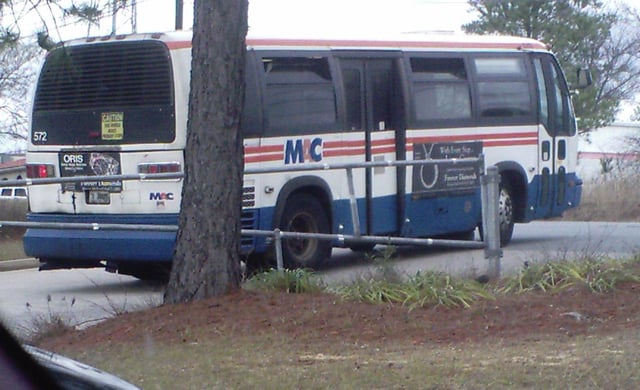
MTA-MAC City Bus
The Macon Transit Authority (MTA) is Macon's public-transit system, operating the Public Transit City Bus System throughout Macon-Bibb County. Most commuters in Macon and the surrounding suburbs use private automobiles as their primary transportation. This results in heavy traffic during rush hour and contributes to Macon's air pollution. The MTA has a total of 10 city bus routes and an express bus that serves suburban Warner Robins just south of the city.
Macon Transit Authority has a tourist trolley system. The trolleys have offered tours of the downtown Macon area since 1999. The tours consist of all of the major historical sites such as the Georgia Music Hall of Fame, the Hay House, and the Tubman Museum. There are three trolleys holding up to 39 passengers.
Intercity bus and rail
Greyhound Lines provides intercity bus service.
Macon grew as a center of rail transport after the 1846 opening of the Macon and Western Railroad.[100] Two of the most note-worthy train companies operating through the city were the Central of Georgia Railway and the Southern Railway. The city continued to be served by passenger trains until the 1960s and early 1970s. The Frisco Railroad's Kansas City-Florida Special served the city until 1964.[101] The Southern's Royal Palm ran from Cincinnati, through Macon, to Miami, Florida until 1966. (A truncated route served to Valdosta, Georgia until 1970.) The Central of Georgia's Nancy Hanks ran through Macon, from Atlanta to Savannah until 1971. Macon is included in the proposed Georgia Rail Passenger Program to restore inter-city rail service.
Pedestrians and cycling
Heritage Trail
Ocmulgee Heritage Trail
Notable people
Sister cities
Macon has six sister cities, as designated by Sister Cities International, Inc. (SCI):[102]
See also
Central Georgia
Downtown Macon, Georgia
Macon, Georgia metropolitan area
List of mayors of Macon, Georgia


